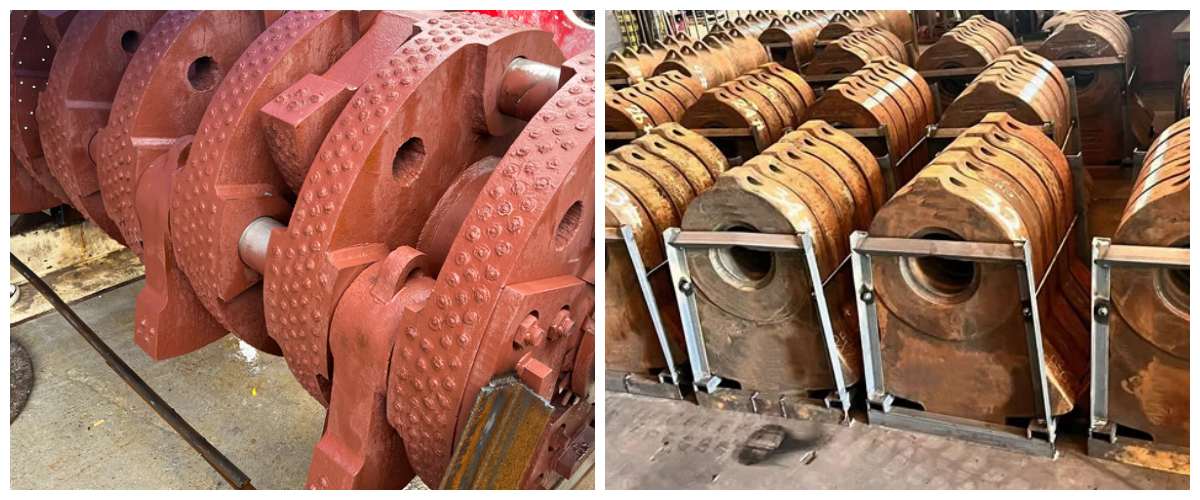Metal crushers are widely used in mining, metallurgy, construction, metal recycling and other production fields, and play an indispensable role in industrial production. As the core component of metal crushers, metal crushing hammers play a vital role. It is like the "heart" of the crusher, and the quality of its performance directly determines the efficiency and quality of the crushing operation. The material selection of the metal crushing hammer is very important in the entire manufacturing process, which directly determines the service life of the hammer.
Zhili New Materials as a professional hammer manufacturer, we mainly produce metal crushing hammers made of high manganese steel, low alloy steel, high chromium cast iron, cemented carbide and other materials. There are still many mysteries in the material of metal hammers. Each material has different advantages and disadvantages. Customers can make reasonable choices according to their working conditions and costs. The following introduces the special features and specific performance of each material.
High manganese steel material
High manganese steel is a traditional and widely used metal crushing hammer material. Its main component is manganese, and the manganese content is usually around 11% - 14%. This steel has excellent toughness and can withstand large impact forces without breaking easily. For example, when crushing ores with high hardness but large blocks, such as granite ores, high manganese steel hammers can rely on their good toughness to remain intact during repeated impacts. High manganese steel also has unique work hardening characteristics. When subjected to large impact or contact stress, its surface layer will quickly produce work hardening. This is like putting a layer of "hard armor" on the surface of the hammer, which significantly improves its wear resistance.
In the early stage of the crushing operation, the surface of the hammer is relatively soft, but as it hits ores and other materials, the surface is constantly impacted and rubbed, resulting in work hardening. However, if the physical impact force is not enough or the contact stress is small in actual work, it is difficult for the high manganese steel hammer to exert its due wear resistance. For example, when crushing some softer and smaller materials, the high manganese steel hammer may wear faster due to the inability to produce sufficient work hardening.
Low alloy steel material
Multi-element low alloy steel is a high-quality material developed in recent years for making hammers. Its matrix structure is martensite, bainite or martensite plus bainite composite structure. This organizational structure makes the low alloy steel hammer head have higher strength and hardness. It is achieved by adding a variety of alloying elements such as chromium, molybdenum, nickel, etc. to the steel to change the organizational structure and performance of the steel. Under the same working conditions, the service life of the low alloy steel hammer head is at least longer than that of the high manganese steel hammer head. For example, in the operation of crushing limestone, the low alloy steel hammer head can maintain good wear resistance and impact resistance. After a long period of use, its wear degree is significantly lower than that of the high manganese steel hammer head. This is because the addition of its alloying elements optimizes the internal organizational structure of the steel and improves its ability to resist wear and impact.
High chromium cast iron material
High chromium cast iron has excellent wear resistance. This is mainly because it contains a high proportion of chromium, and the chromium content is generally around 12% - 28%. Chromium and carbon form a large amount of chromium carbide, which has extremely high hardness and can effectively resist the wear of materials. However, high chromium cast iron has low toughness and is prone to brittle fracture when subjected to a large impact force. This is like a hard but fragile porcelain. Although it is wear-resistant, it may be damaged under complex crushing conditions because it cannot withstand sudden large impact forces. In order to solve the problem of poor toughness of high-chromium cast iron, a composite hammer head was developed. A common way is to cast high-chromium cast iron in the head of a high-manganese steel or low-alloy steel hammer head. For example, high-chromium cast iron is used in the working part of the hammer head, and its high hardness and high wear resistance are used to handle the crushing of materials; while the hammer handle part is made of carbon steel, which has high toughness, so that the hammer head can effectively crush the material, and the hammer handle can withstand the impact force during the crushing process to avoid the overall breakage of the hammer head.
Carbide material
Compared with other materials, carbide hammer heads have higher hardness, bending strength, impact resistance, and thermal fatigue resistance. Its hardness can reach a very high level, and it can easily crush materials with higher hardness. For example, when crushing some extremely hard ores, such as quartz, the high hardness advantage of carbide hammer heads can be fully reflected, and it can effectively crush quartz into the required particle size. The carbide hammer also has good thermal hardness and can maintain good hardness and wear resistance in high temperature environments. Moreover, from a cost perspective, it can solve the problems of cracks, desoldering, collapse, and block falling that are prone to occur in high manganese materials. In the long-term use process, the comprehensive cost is relatively low because of its long service life, which reduces the cost and downtime of frequent replacement of hammers.
It can be seen that there are still many materials for metal crushing hammers, which are worthy of our in-depth study. With the continuous advancement of science and technology, the materials, manufacturing processes and structural design of metal crushing hammers are constantly innovating and developing. Dedicated to new materials, they are also constantly improving their crushing hammer products to meet the requirements of high efficiency, energy saving, and environmental protection for crushing operations in different industries.
